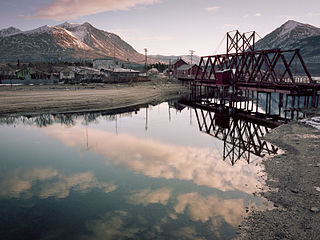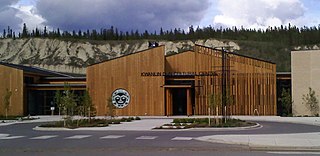
Yukon is the smallest and westernmost of Canada's three territories. It is the third-least populated province or territory in Canada, with a population of 45,750 as of 2024. However, Whitehorse, the territorial capital, is the largest settlement in any of the three territories.

Tutchone is an Athabaskan language spoken by the Northern and Southern Tutchone First Nations in central and southern regions of Yukon Territory, Canada. Tutchone belongs to the Northern Athabaskan linguistic subfamily and has two primary varieties, Southern and Northern. Although they are sometimes considered separate languages, Northern and Southern Tutchone speakers are generally able to understand each other in conversation, albeit with moderate difficulty.

Carcross, originally known as Caribou Crossing, is an unincorporated community in Yukon, Canada, on Bennett Lake and Nares Lake. It is home to the Carcross/Tagish First Nation.

The Kwanlin Dün First Nation (KDFN) or Kwänlin Dän kwächʼǟn is located in and around Whitehorse in Yukon, Canada.

The Carcross/Tagish First Nation is a First Nation native to the Canadian territory of Yukon. Its original population centres were Carcross and Tagish, and Squanga, although many of its citizens also live in Whitehorse. The languages originally spoken by Carcross/Tagish people were Tagish and Tlingit.
The First Nation of Na-Cho Nyäk Dun is a First Nation band government in Yukon, Canada. Its main population centre is in Mayo, Yukon, but many of its members live across Canada and the United States. Members of the First Nation of Na-Cho Nyak Dun claim Gwich'in ancestry, located in north, and Dene ancestry, located in the east, along with their Northern Tutchone ancestry. The Na-cho Nyak Dun are the northernmost representatives of the Northern Tutchone language and culture.
The Ta'an Kwach'an Council or Ta'an Kwäch’än Council is a self-governing Indigenous government whose traditional territory is located around the Whitehorse and Lake Laberge area in Canada's Yukon Territory. It split from the Kwanlin Dün First Nation to negotiate a separate land claim. The language originally spoken by the Ta’an Kwäch’än was Southern Tutchone. The Ta’an Kwäch’än comprise people of Southern Tutchone, Tagish and Tlingit descent. Approximately 50 per cent of the Ta’an Kwäch’än citizens now live in Whitehorse, Yukon Territory, with the balance disbursed throughout the rest of Canada, in the United States of America, and abroad. The Ta'an Kwäch’än take their name from Tàa'an Män in the heart of their traditional territory - so they called themselves ″People from Lake Laberge″.
The Vuntut Gwitchin First Nation (VGFN) is a First Nation in the northern Yukon in Canada. Its main population centre is Old Crow. The language originally spoken by the people is Gwichʼin.
Tagish was a language spoken by the Tagish or Carcross-Tagish, a First Nations people that historically lived in the Northwest Territories and Yukon in Canada. The name Tagish derives from /ta:gizi dene/, or "Tagish people", which is how they refer to themselves, where /ta:gizi/ is a place name meaning "it is breaking up.

The Southern Tutchone are a First Nations people of the Athabaskan-speaking ethnolinguistic group living mainly in the southern Yukon in Canada. The Southern Tutchone language, traditionally spoken by the Southern Tutchone people, is a variety of the Tutchone language, part of the Athabaskan language family. Some linguists suggest that Northern and Southern Tutchone are distinct and separate languages.

The Northern Tutchone are a First Nations people of the Athabaskan-speaking ethnolinguistic group living mainly in the central Yukon in Canada.

Mayo is a village in Yukon, Canada, along the Silver Trail and the Stewart River. It had a population of 200 in 2016. The Yukon Bureau of Statistics estimated a population of 496 in 2019. It is also the home of the First Nation of Na-Cho Nyak Dun, whose primary speak the northern variety of the Tutchone language. Na-Cho Nyäk Dun translates into "big river people."
Jerry Alfred is a Northern Tutchone musician living in Pelly Crossing, Yukon. He received a 1996 Juno Award for his recording ETSI Shon in the category Aboriginal Recording of the Year. His music was featured as part of a Native American photo exhibit at the 1996 Summer Olympics in Atlanta.
The Yukon International Storytelling Festival was held every Summer in Whitehorse, Yukon, generally in an outdoor setting. Cofounders of the storytelling festival were storytellers Louise Profeit-Leblanc and Anne Taylor. Profeit-Leblanc, from the Northern Tutchone Nation, was the niece of Angela Sidney, one the Yukon's last Tagish. Sidney had devoted her life to preserving the stories of the Tagish of Southern Yukon, Profeit-Leblanc and Taylor were motivated to found a more local venue for sharing Yukon stories when they realized that Sidney had had to travel in 1984 to the Toronto Festival of Storytelling to disseminate her peoples' stories to a world audience. In 1987 interested parties came together to plan the first Yukon Storytelling Festival in 1988. It later grew beyond the scope of Yukon and Canada to attract storytellers from all over the world with an emphasis on native peoples storytelling and circumpolar countries.
Angela Sidney, was a Tagish storyteller. She co-authored two narratives of traditional Tagish legends and a historical document of Tagish place names for southern Yukon. For her linguistics and ethnography contributions, Sidney received the Order of Canada, becoming the first Native woman from the Yukon to be so honoured.
"Well, I have no money to leave for my grandchildren. My stories are my wealth!"
Kusawa Lake is a lake in the southern Yukon, Canada. Kusawa means "long narrow lake" in the Tlingit language. The Kusawa Lake is a lake in Canada's Yukon Territory. It is located at an altitude of 671 m (2,201 ft) and is 60 km (37 mi) southwest of Whitehorse near the British Columbia border. It meanders over a length of 75 km (47 mi) with a maximum width of about 2.5 km (1.6 mi) through the mountains in the north of the Boundary Ranges. It is fed by the Primrose River and Kusawa River. The Takhini outflows to the Yukon River from the northern tip of Kusawa Lake. Kusawa Lake has an area of 142 km2 (55 sq mi). The lake has a maximum depth of 140 m (460 ft) and is of glacial origin. It is a common tourist destination and is also popular for fishing.

How People Got Fire is a short, poetic animated film from the Yukon.
Catharine "Kitty" McClellan was an American cultural anthropologist who is known for her documentation of the oral history and storytelling typical of Athabascan speaking, Tlingit and Tagish peoples of the Yukon Territory. Catharine's work extended past her academic research, as she also became an advocate for their rights on issues such as the Mackenzie Valley Pipeline debate in 1976. Her husband was fellow anthropologist John Hitchcock whom she married in 1974; he died in 2001 from natural health complications.

The Indigenous peoples of Yukon are ethnic groups who, prior to European contact, occupied the former countries now collectively known as Yukon. While most First Nations in the Canadian territory are a part of the wider Dene Nation, there are Tlingit and Métis nations that blend into the wider spectrum of indigeneity across Canada. Traditionally hunter-gatherers, indigenous peoples and their associated nations retain close connections to the land, the rivers and the seasons of their respective countries or homelands. Their histories are recorded and passed down the generations through oral traditions. European contact and invasion brought many changes to the native cultures of Yukon including land loss and non-traditional governance and education. However, indigenous people in Yukon continue to foster their connections with the land in seasonal wage labour such as fishing and trapping. Today, indigenous groups aim to maintain and develop indigenous languages, traditional or culturally-appropriate forms of education, cultures, spiritualities and indigenous rights.
The Adäka Cultural Festival is an annual multi-disciplinary arts and culture festival in Whitehorse, Yukon that celebrates First Nations arts and culture, with a specific focus on Yukon First Nations. 'Adäka', in the Southern Tutchone language, means 'coming into the light' which reflects the Yukon First Nations arts and culture being brought forward to the public eye and celebrated by all. The Festival name was inspired by the work of Joe Johnson, the late father of Festival co-founder, Katie Johnson. Several years prior to the launch of Adäka, Johnson had been involved in a conference of the same name. That conference brought the people of the Yukon together to identify areas of concern and exchange thoughts on heritage and culture in the Yukon. The conference aimed to initiate dialogue between the two main Yukon cultures so that everyone could "come into the light" together.










